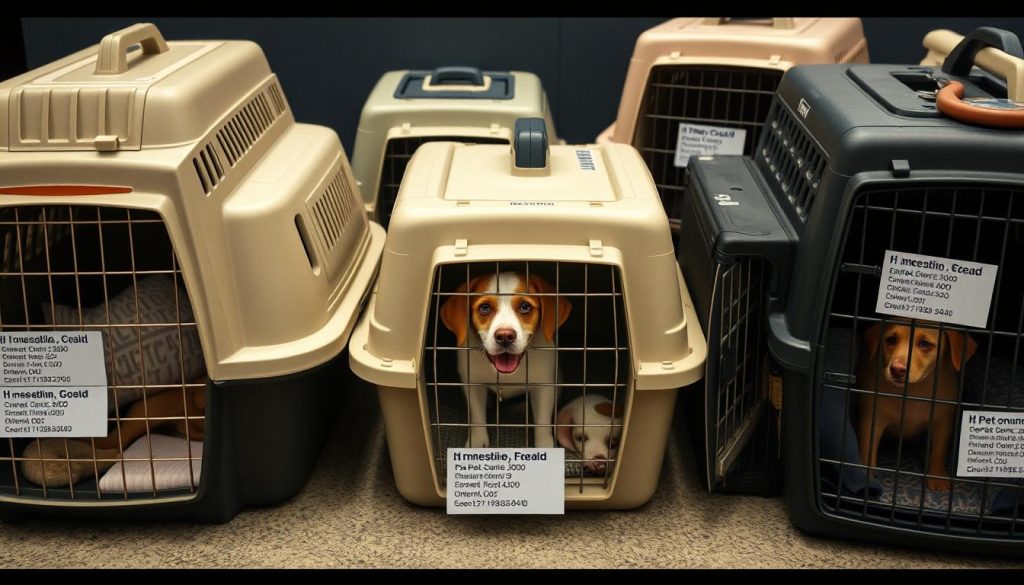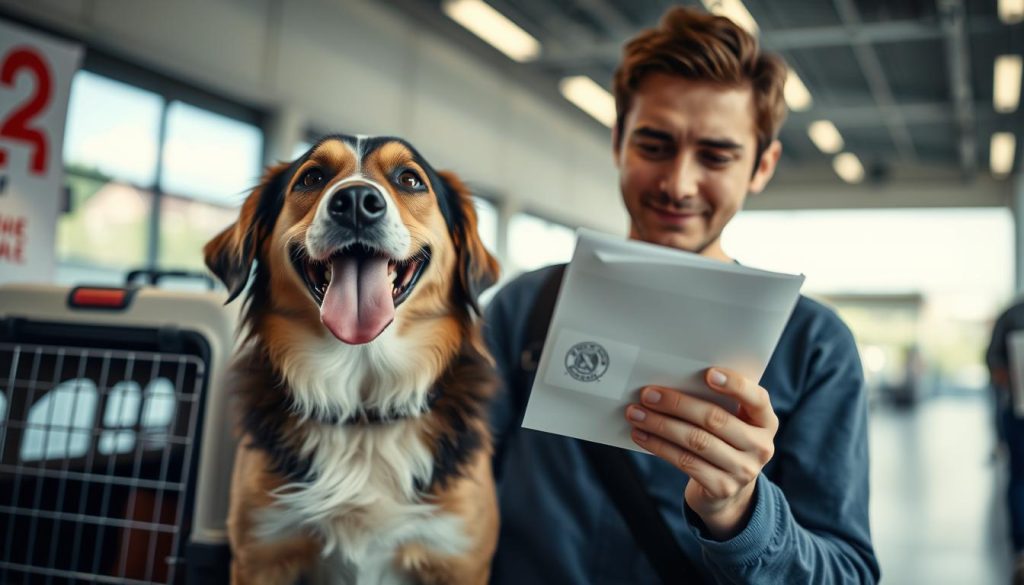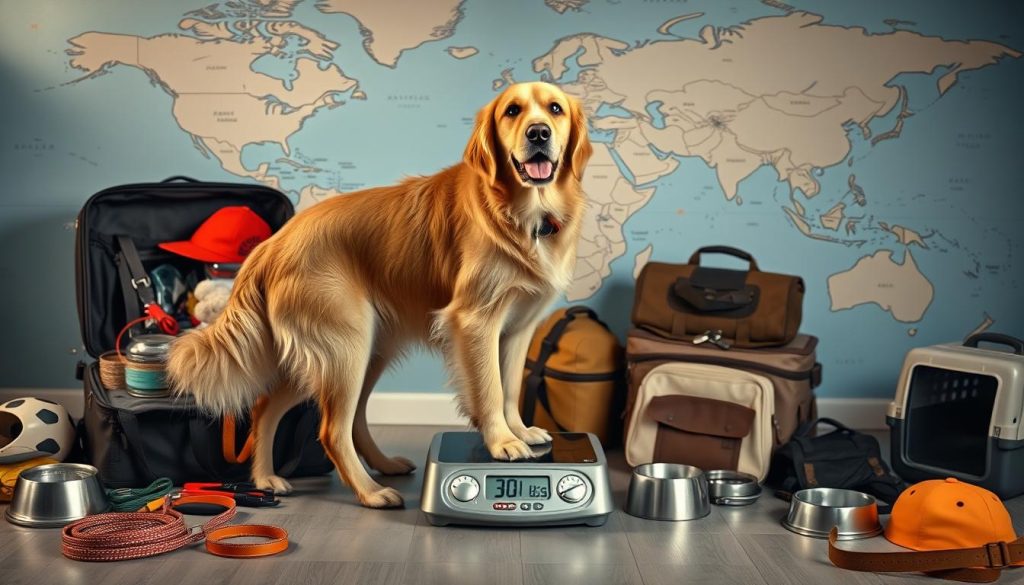Are you planning a trip with your pet? This guide will show you all you need to know about pet travel documents. You’ll learn about the rules for traveling in the U.S. and abroad. It will also cover how to get a pet health certificate, the costs, and more.
Discover the best ways to travel by air or land with your pet. Learn about the things you should watch out for during different seasons. And find out about professional services that can help with pet transport.
With this guide, you’ll be ready to travel safely with your pet. Say goodbye to worries and enjoy your trip together.
Understanding Pet Travel Requirements

Planning a trip with your pet means learning about pet travel rules. These rules can be complex, but knowing them helps make your trip smooth. It makes sure you and your pet have a good time.
Domestic and International Regulations
Travel rules change based on where you’re going, whether it’s in the U.S. or another country. In the U.S., each state has its own rules for pets. You might need a health certificate, up-to-date shots, and a microchip for your pet.
Going abroad adds more rules. You might need proof of rabies shots, special tests, or even a quarantine. Always check these rules early to avoid problems.
State-Specific Entry Laws
- Every U.S. state has its own pet travel requirements you should know.
- You’ll often need a health certificate, updated shots, and a microchip for your pet.
- If you don’t follow state pet entry laws, you might not get in or could face fines.
- Working with your vet is key to making sure your pet meets all the domestic pet travel regulations.
Planning ahead is the secret to a great pet trip. Knowing the international pet travel regulations and state-specific entry laws helps. This way, you and your pet will have a smooth and worry-free trip.
Obtaining a Pet Health Certificate

Getting a pet health certificate is key for a safe trip with your pet. This document, from a USDA-accredited vet, shows your pet is healthy and vaccinated. It lets them travel with you in the U.S. or abroad.
Finding an Accredited Veterinarian
First, book a visit with a USDA-accredited vet. These vets are trained to give the certificate of veterinary inspection needed for pets to travel. Check if your vet is accredited or use the NVAP tool to find one near you.
What to Expect During the Appointment
- Your vet will check your pet’s health and make sure they’re up-to-date on shots.
- They’ll fill out the pet health certificate form with your pet’s details and health info.
- The vet will sign and stamp the certificate, making it official for travel.
Getting a pet health certificate from a USDA-accredited vet is key for your pet’s trip. Make sure your pet is healthy and ready for travel. This way, you can have a safe and worry-free trip together.
Costs of Traveling with Pets

Traveling with your pet can be fun, but remember the costs. You’ll need to think about vet fees, health papers, airline fees, and pet insurance. These things can change how much your pet’s trip costs.
Veterinary Fees and Documentation
Before your pet travels, they need health papers. This means a vet visit for a check-up and shots if needed. Vets charge $25 to $150 for a visit and $20 to $150 for shots, based on your pet and where you are.
Airline Charges and Pet Travel Insurance
Airlines charge extra for pets on flights. These fees are $95 to $125 each way for pets in the U.S. To keep your pet safe and your money safe, think about pet travel insurance. It covers unexpected vet bills or flight problems.
Knowing the costs of pet travel helps you plan and budget for a fun trip with your pet.
The cost of pet travel changes based on distance, pet size, and where you’re going. Always research and plan early for a stress-free and affordable trip with your pet.
Air Travel Options for pet travel documents
Pet owners have two main choices for flying with pets: cabin or cargo travel. Knowing the differences can make flying with your pet easier and safer.
Cabin vs. Cargo Considerations
Small cats and dogs (20 pounds or less) can fly in the cabin with their owners. They must stay in a carrier under the seat during the flight. This way, you can keep your pet close and comfortable. But, not all flights allow in-cabin pets due to limits.
Bigger pets or those without owners go in the cargo area. This might be best for pets not liking the cabin or those too heavy for under-seat carriers. Make sure to check the airline’s cargo pet policies for your pet’s safety.
Airline Restrictions and Policies
It’s key to look at the airline’s pet rules before flying. These rules change a lot between airlines. You need to know about size and weight limits, what documents you need, and any extra fees. Some airlines don’t allow pets in hot or cold weather, so plan ahead.
Learning about pet flying options and airline rules helps you make the best choice for your pet. This way, you can ensure your pet’s comfort and safety on your trip.
Ground Transportation Alternatives
Ground transportation is a great way to move your pets. It’s less stressful than flying and more comfy for them. Some companies even pick up and drop off right at your door.
“Stacked routes” is like pet carpooling. Pets travel together, cutting costs and adding fun. Some services give your pet a personal driver for the trip.
Looking for a pet cab or ground transport? There are many options to get your pets safely to their new home. Knowing your choices helps you pick the best for your pet and your travel needs.
Ground transport is a stress-free way to move pets. You can choose from shared or VIP services. Researching pet transport companies helps you find the best for your pet’s next trip.
Seasonal Precautions and pet travel documents
As a pet owner, I love taking my furry friends on trips. But, the weather changes can make pet travel tricky. It’s key to keep your pet safe and comfy, especially with the changing temperatures.
Summer and Winter Travel Tips
In summer, pets can get too hot and might even suffer from heatstroke. Keep them hydrated, give them shade, and don’t leave them in a hot car. In winter, pets with thin coats or health issues need extra care. Keep them warm, protect them from the cold, and give them breaks.
Before you go, check the weather where you’re headed. This helps you pack right and avoid problems. You might need to bring more supplies or change your travel plans to keep your pet safe.
Being aware of the season’s challenges helps you take good care of your pet. With some planning, you and your pet can have great times together. This is true for summer or winter trips.
Professional Pet Transport Services
As a pet owner, I know how important it is to keep my furry friends safe and comfy while traveling. Sometimes, I can’t take my pet myself. That’s when I look for professional pet transport services. They make sure my pet is safe and happy on the way.
CitizenShipper is a great place to find these services. It’s an online marketplace that connects me with trusted transporters. I can easily find the right person for my pet’s needs, whether it’s a long trip or a short one. The site is easy to use and shows clear prices, so I can pick the best service for my pet.
Using professional pet transport services helps me relax, knowing my pet is with experts. These companies focus on the pets’ safety and comfort. They follow strict rules and give my pet the care it needs. This makes sure my pet travels well and without stress.

